
A funeral is a ceremony connected with the final disposition of a corpse, such as a burial or cremation, with the attendant observances. Funerary customs comprise the complex of beliefs and practices used by a culture to remember and respect the dead, from interment, to various monuments, prayers, and rituals undertaken in their honour. Customs vary between cultures and religious groups. Funerals have both normative and legal components. Common secular motivations for funerals include mourning the deceased, celebrating their life, and offering support and sympathy to the bereaved; additionally, funerals may have religious aspects that are intended to help the soul of the deceased reach the afterlife, resurrection or reincarnation.
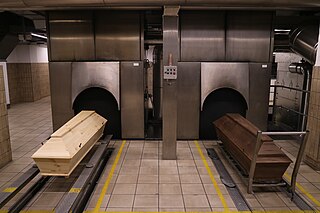
Cremation is a method of final disposition of a dead body through burning.

The majority of funerals in Japan include a wake, the cremation of the deceased, a burial in a family grave, and a periodic memorial service. According to 2007 statistics, 99.81% of deceased Japanese are cremated.
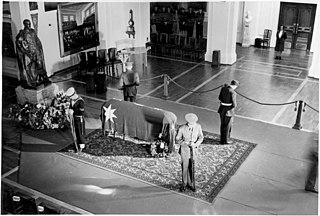
A state funeral is a public funeral ceremony, observing the strict rules of protocol, held to honour people of national significance. State funerals usually include much pomp and ceremony as well as religious overtones and distinctive elements of military tradition. Generally, state funerals are held in order to involve the general public in a national day of mourning after the family of the deceased gives consent. A state funeral will often generate mass publicity from both national and global media outlets.

Antyesti literally means "last sacrifice" or "final auspicious ceremony", and refers to the funeral rites for the dead in Hinduism, which usually involves cremation of the body. This rite of passage is the last samskara in a series of traditional life cycle samskaras that start from conception in Hindu tradition. It is also referred to as Antima Samskara, Antya-kriya, Anvarohanyya, or as Vahni Samskara.

A Christian burial is the burial of a deceased person with specifically Christian rites; typically, in consecrated ground. Until recent times Christians generally objected to cremation because it interfered with the concept of the resurrection of a corpse, and practiced inhumation almost exclusively. Today this opposition has all but vanished among Protestants and Catholics alike, and this is rapidly becoming more common, although Eastern Orthodox Churches still mostly forbid cremation.
Icelandic funerals are ceremonies that are largely shaped by the Evangelical Lutheran Church of Iceland, the largest Christian organisation in Iceland. However, customs may vary depending on religious group.
The Liberation Rite of Water and Land, also known as Shuilu Fa Hui (水陸法會), Shuilu Daochang (水陸道場), or Shuilu Dahui (水陸大會), is a Chinese Buddhist ritual performed by temples and presided over by high monks. The service is often credited as one of the greatest rituals in Chinese Buddhism, as it is also the most elaborate and requires the labor of monastics and temple staff and the financial funding of lay Buddhist sponsors. The ceremony is attributed to the Emperor Wu of Liang, who was inspired one night when he had a dream in which a monk advised him to organize a ceremony to help all beings living on land and in the seas to be surfeited from their suffering, hence the name of the rite. The ritual itself was compiled by the Chan Buddhist master Bao Zhi.
Among Buddhists, death is regarded as one of the occasions of major religious significance, both for the deceased and for the survivors. For the deceased, it marks the moment when the transition begins to a new mode of existence within the round of rebirths. When death occurs, all the karmic forces that the dead person accumulated during the course of their lifetime become activated and determine the next rebirth. For the living, death is a powerful reminder of the Buddha's teaching on impermanence; it also provides an opportunity to assist the deceased person as they transition to a new existence. There are several academic reviews of this subject. In Buddhism, death marks the transition from this life to the next for the deceased.
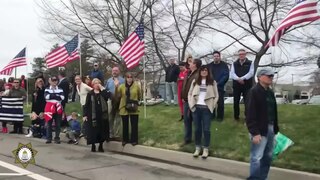
A funeral procession is a procession, usually in motor vehicles or by foot, from a funeral home or place of worship to the cemetery or crematorium. In earlier times the deceased was typically carried by male family members on a bier or in a coffin to the final resting place. This practice has shifted over time toward transporting the deceased in a hearse, while family and friends follow in their vehicles. The transition from the procession by foot to procession by car can be attributed to two main factors; the switch to burying or cremating the body at locations far from the funeral site and the introduction of motorized vehicles and public transportation making processions by foot through the street no longer practical.
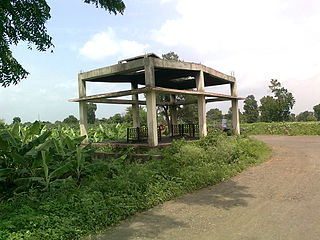
A shmashana is a Hindu crematory ground, where dead bodies are brought to be burnt on a pyre. It is usually located near a river or body of water on the outskirts of a village or town; as they are usually located near river ghats, they are also regionally called smashan ghats.

Phraya Anuman Rajadhon, was one of modern Thailand's most remarkable scholars. He was a self-trained linguist, anthropologist and ethnographer who became an authority on the culture of Thailand. His name was Yong Sathirakoses ; Phraya Anuman Rajadhon was his noble title. He also took his family name, Sathirakoses, as a pen name by which he is well known.
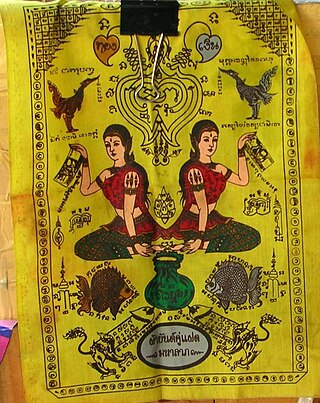
Thai folklore is a diverse set of mythology and traditional beliefs held by the Thai people. Most Thai folklore has a regional background for it originated in rural Thailand. With the passing of time, and through the influence of the media, large parts of Thai folklore have become interwoven with the wider popular Thai culture.

King Bhumibol Adulyadej of Thailand died at the age of 88 on 13 October 2016, after a long illness. A year-long period of mourning was subsequently announced. A royal cremation ceremony took place over five days at the end of October 2017. The actual cremation, which was not broadcast on television, was held in the late evening of 26 October 2017. Following cremation his remains and ashes were taken to the Grand Palace and were enshrined at the Chakri Maha Phasat Throne Hall, the Royal Cemetery at Wat Ratchabophit and the Wat Bowonniwet Vihara Royal Temple. Following burial, the mourning period officially ended on midnight of 30 October 2017 and Thais resumed wearing colors other than black in public.

Thai royal funerals are elaborate events, organised as royal ceremonies akin to state funerals. They are held for deceased members of the royal family, and consist of numerous rituals which typically span several months to over a year. Featuring a mixture of Buddhist and animist beliefs, as well as Hindu symbolism, these rituals include the initial rites that take place after death, a lengthy period of lying-in-state, during which Buddhist ceremonies take place, and a final cremation ceremony. For the highest-ranking royalty, the cremation ceremonies are grand public spectacles, featuring the pageantry of large funeral processions and ornate purpose-built funeral pyres or temporary crematoria known as merumat or men. The practices date to at least the 17th century, during the time of the Ayutthaya Kingdom. Today, the cremation ceremonies are held in the royal field of Sanam Luang in the historic centre of Bangkok.
The royal cremation ceremony is the final and most major event during Thai royal funerals.

Phongyibyan is a Burmese language term for the ceremonial cremation of high-ranking Buddhist monks, in particular monks from Myanmar's largest Buddhist order, the Thudhamma Nikaya.

The coronation of Vajiralongkorn (Rama X) as king of Thailand took place on 4 May 2019 at the Grand Palace, Bangkok. He ascended the throne at the age of 64 upon the death of his father, Bhumibol Adulyadej, on 13 October 2016, accepting the accession invitation by Prem Tinsulanonda, president of the Privy Council, on 1 December 2016. The coronation was held within just three years after his accession to the throne in 2016 because of an appropriate length of time to pass after the death and funeral of Bhumibol Adulyadej and the arrangement of the ceremony after the last such rite having been held in 1950.
Cremation in Japan was originally practiced by monks seeking to emulate the cremation of the Buddha. Virtually all deceased are now cremated in Japan – as of 2012, it had the highest cremation rate in the world of over 99.9%. The Meiji government attempted to ban the practice in the 19th century, but the ban was only in effect for less than two years.

Cremation volumes are a genre of printed literature found in Thailand. They are commemorative books given as gifts to guests at Thai funerals, and usually include a biography of the deceased as well as other literary material. Their publication, which dates to the late nineteenth century, was initiated among royalty and nobility, then taken up by wealthy commoners and, later, the wider middle class. These books, whose contents range from compilations of religious texts and historical manuscripts to essays and writings on general knowledge in various fields, are regarded as a valuable historical source by Thai studies scholars, and are actively collected and traded.

















